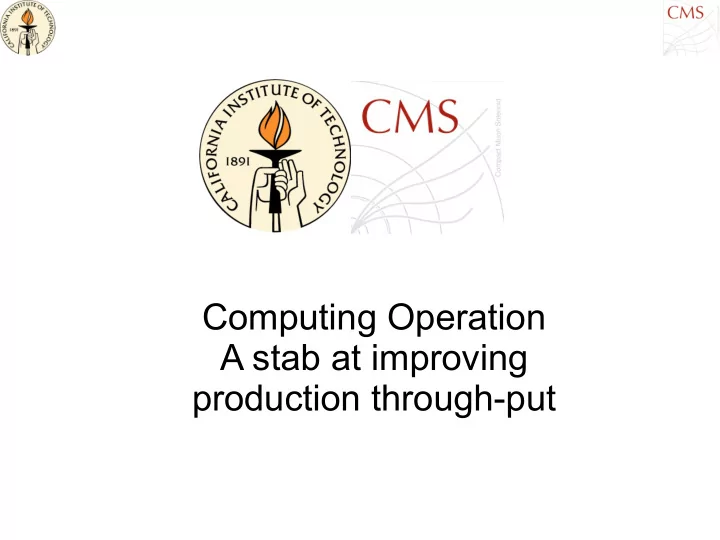

Computing Operation A stab at improving production through-put
Outlook ● Figure out cleaning procedures, people would like to use DDM for managing dataops space : will require some work , headache and and testing ● Alert system : to get an indication that something is being held for assignment ● Time monitoring : to see the dynamic of workflows passing through the system ● Figure out a better “# of copies” strategy, size ? Estimated CPU ? Priority ? … transfer are parallel = no delays added ? ● Tune parameters to prevent starvation ● We were almost there, but then we added several T2s to the digi-reco pool and things are going very fast through. ● Let it run and have Matteo (co-L3) take care of it every other week 05/19/15 CalTech Group Meeting 2
Overview ● McM is the service for organizing, configuring and book-keeping the production requests from all PAG/POG/DPG https://cms-pdmv.cern.ch/mcm/ https://twiki.cern.ch/twiki/bin/view/CMS/PdmVMcM ● Request Manager is the production service for book-keeping actual production requests https://cmsweb.cern.ch/reqmgr/ ● Why two ? ➢ PREP/reqmgr development went in parallel. Reqmgr aimed at doing prep job ➢ McM rewrote PREP with more integration to reqmgr ➢ Reqmgr is production oriented while mcm is book-keeping and information oriented ➢ Chaining of workflows is not a concept of reqmgr ➢ In a nutshell One does the preparation/book-keeping one does the production ➢ More integration possible (mcm under cmsweb, simplify the interface,...) ● Wmagent is/are ➢ pulling workload from request manager and pushing production jobs to sites ➢ Injecting data to dbs & phedex ● This is not enough to do the job 05/19/15 CalTech Group Meeting 3
What was missing ● What sites to use for what purpose ● How much to queue to sites ● Where to locate input data when needed ● When is the data placed and ready to be used ● Is the production complete and sane ● Where to place the output for users ● All this, or most has been done by hand ● Lots of automation were put in “gen-sim” production (including fastsim) ● Not much was done for “digi-reco” 05/19/15 CalTech Group Meeting 4
Goals and Strategy ● Reduce manual intervention to the minimum (that always fail in commissioning part) ➔ Adopt a set of generic rules that should lead to a stable operation ● Reduce latency for delivery of samples ➔ Automatize all steps for requests not having any issue ● Reduce re-shuffling of priorities ➔ Spread the load using multi-site white list systematically ● Increase throughput ➔ Use as many sites as possible 05/19/15 CalTech Group Meeting 5
Implementation ● Python modules developed from previous scripts https://github.com/CMSCompOps/WmAgentScripts ● Unify handling of all request type to unique software https://github.com/CMSCompOps/WmAgentScripts/tree/master/Unified ● Documentation from the beginning https://twiki.cern.ch/twiki/bin/view/CMSPublic/CompOpsWorkflowL3Responsibilities#Automatic_Assignment_and_Unified ● Monitoring from day one https://cmst2.web.cern.ch/cmst2/unified/ ● Adopt a set of representative statuses (see next slide) ● Use a simple database back-end sqlite file with python sqlalchemy library http://www.sqlalchemy.org/ ● Hourly polling cycles ● Configuration global or by campaign ● All modules can be run by hand with option to push the system when necessary 05/19/15 CalTech Group Meeting 6
From assignment-approved Cloned Modules considered ● injector Input needed ● transferor ● stagor No input staging ● Assignor needed Input available Cloned ● checkor ● closor staged ● cleanor Cloned forget ● rejector Assignment Rejected trouble ● Jean-Roch Vlimant away issues completed Aborted assistance completed close Closed-out done Remove input clean 05/19/15 CalTech Group Meeting 7
Rules ● Look at workflows in term of input needed ➢ if none go with all T2s and T1s ➢ If primary input but no secondary, same ➢ If secondary (PU) go with T1s and strong T2s ● Distribute secondary systematically to all site in whitelist ● Distribute primary inputs to a produce a certain number of copies (3) of the input dataset across all sites in whitelist ➢ Dataset are chopped in 1TB chunk, and these chunks are spread ● Once initiated transfers complete, use also residual blocks of input at other site to inflate site whitelist ● Assign to sites, restricted to where secondary is “wmagent business interlude” ● Once completed, check for processing completion, data injection completion to dbs, phedex, check lumisize, lumi duplications, custodial replication requests ➢ If checking out, output passed on to ddm (when applicable) and back to McM ➢ If not, initiate custodial, wait for data injection, or let operators create recovery workflows ● Two days from completion, clean the input dataset from disk (except for one copy?) ● Clean the output ● Completely from disk if one copy under analysis ops (DDM) ● Keep a full copy on disk if none under analysis ops 05/19/15 CalTech Group Meeting 8
Recommend
More recommend